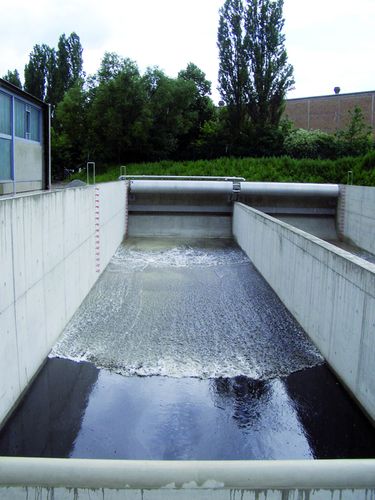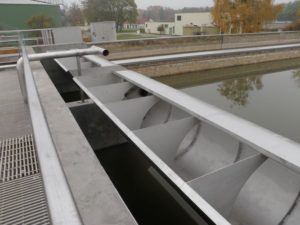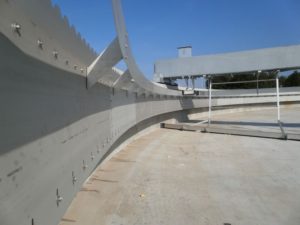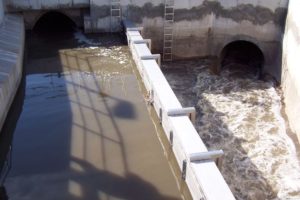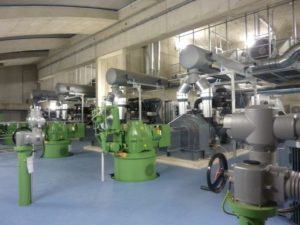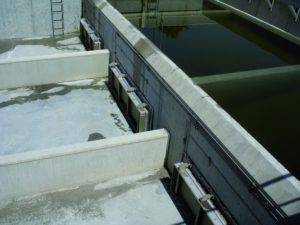Einsatzgebiete | Anwendung
- Sammelbecken bzw. Stauanlage als Bestandteil kommunaler Netze oder industrieller Anlagen
- Eingesetzt als Stausystem zur gedrosselten Abgabe des Abwassers im Starkregenfall an das nachfolgende Kanalsystem bzw. der Kläranlage
Produktbeschreibung
Entwässerungsnetze haben die Aufgabe, neben dem Schmutzwasser auch das in die Kanalisation gelangende Niederschlagswasser schadlos abzuführen, um den Mischwasserabfluss auf das wirtschaftlich und verfahrenstechnisch vertretbare Maß zu begrenzen. Dabei ist die Belastung der Fließgewässer durch die Einleitung aus einer Mischkanalisation möglichst gering zu halten.
Regenrückhaltesysteme sollen in Ereignisfällen große Mengen Mischwasser aufnehmen und geregelt abgeben. Die eingesetzte verfahrenstechnische Systemlösung sichert die geregelte Zu- und Ableitung des Regenwassers sowie die automatisierte Reinigung des Beckens.
Der reguläre Trockenwetterabfluss im Transportkanal oder Hauptsammler passiert ein Trennbauwerk. Die Wartung der Kanäle kann durch manuelle Spülungen oder Spülwagen erfolgen. Eine mechanische oder elektromechanische Drosseleinrichtung am Trennbauwerk regelt selbständig die Einhaltung des geplanten Abflusses zur Kläranlage. Tritt ein regionales Ereignis ein, treffen erhebliche Mischwassermengen und gelöste Ablagerungen aus dem oberen Kanalnetz auf das Trennbauwerk. Die aktivierte Drossel erzeugt einen Aufstau. Mit dem folgenden Entlastungsprozess über die Trennschwelle können Ziele der Kanalbewirtschaftung und der Rückhaltung von Schwimmstoffen realisiert werden. Hierzu kommen mechanische oder elektromechanische Entlastungsklappen bzw. aufschwimmende Tauchwände oder automatische Scheibenfilter, ggf. Stabfeinrechen zum Einsatz.
Ein Beckenüberlauf schützt das nachfolgende Regenbecken vor Überlastung, reguliert die Funktion des Klärüberlaufes und enthält i.d.R. die Hochwasserschutzeinrichtung mittels Klappen oder elektromechanische Schieber. Das Regenbecken nimmt die geplante Mischwassermenge auf und regelt gegebenenfalls unter Verwendung mechanischer Einbauten den Klärüberlauf. Nach der Restentleerung des Regenbeckens werden Strahlreiniger, Spülklappen oder Spülkippen, die gekoppelt oder prozessgesteuert ausgeführt sind, für die selbständige Spülung der Beckensohle eingesetzt. Die Art der automatischen Reinigung resultiert aus den örtlichen Bedingungen mit Gefälle, Spül- und Pumpensumpf sowie den Betreiberansprüchen.
Die wks group unterstützt mit Beratungen über Vorteile und Einsatzgrenzen von Ausrüstungen und Steuerungen, liefert und montiert betriebsbereit und bietet Service in Objektnähe.
Konstruktionsmerkmale
- Pumpwerke
- Reinigungseinrichtungen zur Grobstoffrückhaltung wie Scheibenfiltersystem oder Stabfeinrechen
- Tauchwände zur Schwimmstoffrückhaltung
- Klappen und Wehre zur Stauzielregulierung
- Spüleinrichtungen (Schwallspülung) wie Spülkippen oder Spülklappen
- Durchflussregelsysteme wie Drosseln und Abflussregler
- Steuer- und Regelsystem für den vollautomatischen Betrieb
- Optionale Einbindung in Prozessleitsystem
Vorteile
- Ausrüstungskomponenten in Systemlösung integriert, damit optimale Funktionseigenschaften sowie verminderte Investitions- und Betriebskosten
- Wesentliche Erhöhung der Funktionssicherheit und Zuverlässigkeit gegenüber Einzellösungen
- Variables und den Bedingungen angepasstes Spektrum der technischen Ausrüstung
- Vollautomatisierter Betrieb mit individuell angepasstem Steuer- und Regelsystem
- Spüleinrichtungen (Spülkippe) fremdenergiefrei und mit geringem Spülwasserbedarf
- Gute Bedienungs- sowie Wartungsbedingungen
- Komponenten und System für Nachrüstung und Ertüchtigung von Regenrückhaltesystemen geeignet
